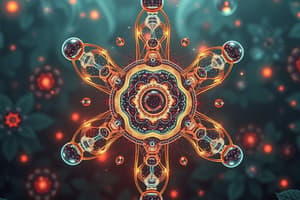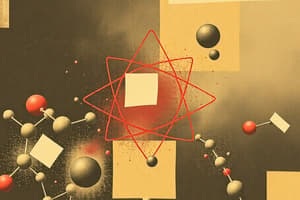Podcast
Questions and Answers
What determines the atomic mass of an element?
What determines the atomic mass of an element?
- The sum of the atomic numbers of all its atoms
- The number of electrons in the element
- The weight of the element in grams
- The sum of the masses of protons and neutrons (correct)
What is the relationship between the number of protons and the atomic number?
What is the relationship between the number of protons and the atomic number?
- The atomic number is the sum of protons and neutrons
- The atomic number is always greater than the number of protons
- The atomic number represents only the number of neutrons
- The number of protons is equal to the atomic number (correct)
Which statement about protons and neutrons is incorrect?
Which statement about protons and neutrons is incorrect?
- Protons contribute positively to the atomic mass
- Protons are not included in the calculation of atomic mass (correct)
- Neutrons do not affect the atomic charge
- Neutrons contribute to the overall mass of the atom
How does increasing the number of protons in an atom affect its atomic number?
How does increasing the number of protons in an atom affect its atomic number?
If an element has 12 protons, what will its atomic number be?
If an element has 12 protons, what will its atomic number be?
How does the energy of an electron change in relation to its distance from the nucleus?
How does the energy of an electron change in relation to its distance from the nucleus?
What does the suborbital quantum number (l) primarily indicate?
What does the suborbital quantum number (l) primarily indicate?
Which statement about the region of greatest probability of finding an electron is correct?
Which statement about the region of greatest probability of finding an electron is correct?
Which of the following factors does NOT influence the energy of an electron in an atom?
Which of the following factors does NOT influence the energy of an electron in an atom?
What happens to an electron's energy as it is located farther from the nucleus?
What happens to an electron's energy as it is located farther from the nucleus?
How many groups correspond to the filling of s and p orbitals in the periodic table?
How many groups correspond to the filling of s and p orbitals in the periodic table?
In which periods are the s and p orbitals filled in a normal fashion?
In which periods are the s and p orbitals filled in a normal fashion?
What determines the number of groups in the periodic table related to s and p orbital filling?
What determines the number of groups in the periodic table related to s and p orbital filling?
What happens through Periods 2 and 3 in the context of orbital filling?
What happens through Periods 2 and 3 in the context of orbital filling?
What is the relationship between the groups and rows of the periodic table?
What is the relationship between the groups and rows of the periodic table?
Why may the electronic structure of an ion not reveal the level from which an electron was lost?
Why may the electronic structure of an ion not reveal the level from which an electron was lost?
Which of the following statements about transition elements is true?
Which of the following statements about transition elements is true?
What characteristic of transition elements complicates the understanding of their ionization?
What characteristic of transition elements complicates the understanding of their ionization?
What does the statement regarding the change in relative orbital energies imply?
What does the statement regarding the change in relative orbital energies imply?
Which factor primarily affects the identification of the lost electron's level in transition elements?
Which factor primarily affects the identification of the lost electron's level in transition elements?
What is the role of the donor species in a chemical interaction?
What is the role of the donor species in a chemical interaction?
Which of the following best describes the acceptor species?
Which of the following best describes the acceptor species?
What type of complex is mentioned as an example of donor-acceptor interaction?
What type of complex is mentioned as an example of donor-acceptor interaction?
How does the orbital interaction occur between the donor and acceptor species?
How does the orbital interaction occur between the donor and acceptor species?
Which of these characteristics is not associated with the donor species?
Which of these characteristics is not associated with the donor species?
Flashcards are hidden until you start studying
Study Notes
Atomic Mass and Atomic number
- The atomic mass of an element is primarily determined by the combined mass of its protons and neutrons.
- The number of protons in an atom is equal to its atomic number.
Electronic Structure
- The energy associated with an electron increases as its distance from the nucleus increases.
Suborbital Quantum Number (l)
- The suborbital quantum number (l) describes the shape and size of the region where an electron is most likely to be found.
- The shape and size of the region vary depending on the energy level of the electron.
Electronic Structure of Ions
- The electronic structure of an ion may sometimes not reveal the level from which an electron was lost, especially in transition elements.
- This occurs because relative orbital energies can change when electrons are added to orbitals.
Groups in the Periodic Table
- There are eight groups in the periodic table, corresponding to the filling of s and p orbitals.
- The principal quantum number of these orbitals is equal to the period or row number of the table.
- In periods 2 and 3, the s and p orbitals are filled in a standard fashion.
Chemical Bonding
- The entity providing a pair of electrons in a chemical bond is called the donor species.
- The acceptor species is electron-deficient and has an empty orbital capable of overlapping with the orbital from the donor.
- An example of this type of bond is the boron-trifluoride etherate complex.
Studying That Suits You
Use AI to generate personalized quizzes and flashcards to suit your learning preferences.




